#scaffold trend
Text

At long last, I have found a desk that satisifies my seemingly-simple-yet-somehow-actually-impossibly-arcane demands. It's a close cousin to the desk I left behind before moving to Scotland, minus that desk's ~200lb slate top (which is why I rejected the possibility of shipping it here). After 12 years without a desk, I'm looking forward to putting things in drawers & pulling out those little slab shelves.
Its top is also nicely aged/dinged up & I will enjoy running my hands over it -- see below:

It's going to be a tight squeeze to get it into the room where I plan to use it, so let's hope I can channel my crafty-furniture-mover persona (or that the top comes off easily).
#I do not know what is up with current desk trends#everything is either scaffolding wood badly stained & somehow steampunked with pipes#or like a flimsy-looking door on hairpin legs#occasionally you can find something attractive but then of course the price is ludicrous#and even on an expensive desk#something has happened where no one seems to want drawers#drawers are key to the desk experience for me#that's ~40% of the reason to have a desk#anyhow I think this desk & I will be happy together#although now I have to find a CHAIR for fuck's sake#let's hope that doesn't take another 12 years#every chair I've liked costs more than the desk did#so we're not off to a great start
10 notes
·
View notes
Text
Global Biodegradable Scaffold Market Is Estimated To Witness High Growth Owing To Rising Demand for Regenerative Medicine
The global Biodegradable Scaffold Market is estimated to be valued at US$1.02 billion in 2021 and is expected to exhibit a CAGR of 18% over the forecast period of 2022 to 2031, as highlighted in a new report published by Coherent Market Insights.
A) Market Overview:
Biodegradable scaffolds are three-dimensional structures designed to support cell growth and tissue regeneration. These scaffolds provide a temporary framework for cells to attach and grow, ultimately promoting new tissue formation. They are used in various applications such as bone tissue engineering, wound healing, cardiovascular repair, and organ transplantation. The advantage of biodegradable scaffolds is that they eliminate the need for surgical removal since they degrade naturally in the body over time. The increasing prevalence of chronic diseases and the growing demand for regenerative medicine are driving the market growth.
B) Market Key Trends:
One key trend observed in the biodegradable scaffold market is the rising demand for regenerative medicine. Regenerative medicine aims to restore the structure and function of damaged tissues or organs by using a combination of biomaterials, cells, and growth factors. Biodegradable scaffolds play a crucial role in this field by providing a platform for cell attachment, proliferation, and differentiation. They act as a temporary support system until the body's own cells can regenerate the tissue. For example, in bone tissue engineering, biodegradable scaffolds help stimulate new bone formation and facilitate the healing process. This trend is driven by the increasing geriatric population, rising prevalence of chronic diseases, and advancements in stem cell research.
C) PEST Analysis:
- Political: Government regulations and policies regarding the use of biodegradable materials and tissue engineering technologies can impact market growth.
- Economic: The economic stability of a region influences investments in healthcare infrastructure and research and development activities in the field of regenerative medicine.
- Social: The acceptance and awareness of regenerative medicine among the general population and healthcare professionals influence the adoption of biodegradable scaffolds.
- Technological: Advancements in 3D printing, nanotechnology, and biomaterials have enabled the development of innovative and more effective biodegradable scaffolds.
D) Key Takeaways:
- The Global Biodegradable Scaffold Market Size is expected to witness high growth, exhibiting a CAGR of 18% over the forecast period, due to increasing demand for regenerative medicine.
- North America is anticipated to be the fastest-growing and dominating region in the market, driven by well-established healthcare infrastructure, high healthcare expenditure, and supportive government initiatives.
- Key players operating in the global biodegradable scaffold market include Merck KGaA, 3D Biotek LLC, Medtronic, Xanofi, Akron Biotech, Nanofiber Solutions, Vericel Corporation, NuVasive, Inc., Organogenesis, Inc., Biostage, Inc., In2Bones Global, Orthofix Medical Inc., Spine Smith, Invivo Therapeutics Holdings Corp., and Onkos Surgical. These companies focus on strategic collaborations, acquisitions, and product innovations to strengthen their market position.
In conclusion, the global biodegradable scaffold market is expected to witness significant growth driven by the rising demand for regenerative medicine. The use of biodegradable scaffolds in tissue engineering applications provides a promising approach for facilitating tissue regeneration and improving patient outcomes. The market is characterized by technological advancements in biomaterials and 3D printing techniques, which enable the development of more advanced and personalized scaffolds. Regionally, North America is expected to be the fastest-growing market due to favorable healthcare infrastructure and government support. Key players in the market continue to invest in research and development activities to launch innovative products and gain a competitive edge.
#Biodegradable Scaffold Market#Biodegradable Scaffold Market Insights#Biodegradable Scaffold Market Trends#Biodegradable Scaffold Market Analysis#tissue regeneration#scaffolds#healthcare expenditure#cardiovascular disease#orthopedic disorders#Coherent Market Insights
0 notes
Text
Biological Scaffold Market Trends, Outlook, Revenue and Forecast 2022-2028
This report provides a comprehensive analysis of current Global Biological Scaffold Market based on segmented types and downstream applications. Major product development trends are discussed under major downstream segment scenario.
This report also focuses on major driving factors and inhibitors that affect the market and competitive landscape. Global and regional leading players in the Biological Scaffold industry are profiled in a detailed way, with sales data and market share info. This report also includes global and regional market size and forecast, drill-down to top 20 economies.
According to this survey, the global Biological Scaffold market is estimated to have reached $ xx million in 2020, and projected to grow at a CAGR of xx% to $ xx million by 2028.
Get Sample Request @ https://martresearch.com/contact/request-sample/2/63151
Covid-19 pandemic has impacted the supply and demand status for many industries along the supply chain. Global Biological Scaffold Market Status and Forecast 2022-2028 report makes a brilliant attempt to unveil key opportunities available in the global Biological Scaffold market under the covid-19 impact to help readers in achieving a better market position. No matter the client is industry insider, potential entrant or investor, the report will provide useful data and information.
The Global Biological Scaffold Market has been exhibited in detail in the following chapters
Chapter 1 displays the basic product introduction and market overview.
Chapter 2 provides the competition landscape of global Biological Scaffold industry.
Chapter 3 provides the market analysis by type and by region
Chapter 4 provides the market analysis by application and by region
Chapter 5-10 presents regional and country market size and forecast, under the context of market drivers and inhibitors analysis.
Chapter 11 analyses the supply chain, including process chart introduction, upstream key raw material and cost analysis, distributor and downstream buyer analysis.
Chapter 12 provides the market forecast by type and by application
Chapter 13 provides the market forecast by region
Chapter 14 profiles global leading players with their revenue, market share, profit margin, major product portfolio and SWOT analysis.
Chapter 15 conclusions
Segmented by Type
l Hydrogels
l Polymeric Scaffolds
Segmented by Application
l Stem Cell Therapy
l Regenerative Medicine
l Tissue Engineering
l Drug Discovery
l Others
Buying And Enquiry @ https://martresearch.com/contact/enquiry/2/63151
Segmented by Country
North America
United States
Canada
Mexico
Europe
Germany
France
UK
Italy
Russia
Spain
Asia Pacific
China
Japan
Korea
Southeast Asia
India
Australasia
Central & South America
Brazil
Argentina
Colombia
Middle East & Africa
Iran
Israel
Turkey
South Africa
Saudi Arabia
Get Discount @ https://martresearch.com/contact/discount/2/63151
Key manufacturers included in this survey
l Thermo Fisher Scientific, Inc
l Tecan Trading AG
l REPROCELL Inc
l Pelobiotech
l NuVasive, Inc
l Nanofiber Solutions
l Molecular Matrix, Inc
l Merck KGaA
l Medtronic
l Matricel GmbH
l Corning Incorporated
l Bioquote Ltd
l Becton, Dickinson, and Company
l Avacta Life Sciences Limited.
l Allergan
l Akron Biotech
l 4titude
l 3D Biotek LLC
Contact Us:-
+1-857-300-1122
0 notes
Text
Scaffold Technology Market Industry Share, Size, Growth, Demands, Revenue, Top Leaders and Forecast to 2028

Industry Analysis
The scaffold technology market is expected to witness market growth at a rate of 8.89% in the forecast period of 2021 to 2028 and is expected to reach 2,254.07 USD million by 2028.
Additionally, the credible Scaffold Technology Market report helps the manufacturer in finding out the effectiveness of the existing channels of distribution, advertising programs, or media, selling methods and the best way of distributing the goods to the eventual consumers. Taking up such market research report is all the time beneficial for any company whether it is a small scale or large scale, for marketing of products or services. It makes effortless for healthcare industry to visualize what is already available in the market, what market anticipates, the competitive environment, and what should be done to surpass the competitor.
Get a Free Sample of The Report: https://www.databridgemarketresearch.com/request-a-sample/?dbmr=global-scaffold-technology-market
Market Insights and Scope
Scaffolds can be defined as the artificial extracellular matrices that support the 3D tissue regenerations and accommodate cells. These can be either permanent or temporary matrices which offer mechanical, chemical and biological support for the tissue formation. Scaffold technology is applied to present 3D culture assays that involve cell to cell interactions, high throughput screening, cell to matrix interactions, transfections, and cell migration assays.
An international Scaffold Technology Market research report examines competitive companies and manufacturers in the global market. Competitive analysis carried out in this market report puts forth the moves of the key players in the healthcare industry such as new product launches, expansions, agreements, joint ventures, partnerships, and recent acquisitions. This market report puts light on various aspects of marketing research that range from important industry trends, market size, market share estimates, sales volume, emerging trends, product consumption, customer preferences, historic data along with future forecast and key player analysis. It studies market by product type, applications and growth factors.
Get full access to the report: https://www.databridgemarketresearch.com/reports/global-scaffold-technology-market
Industry Segmentation
The scaffold technology market is segmented on the basis of type, application, disease and end use. The growth amongst these segments will help you analyse meagre growth segments in the industries, and provide the users with valuable market overview and market insights to help them in making strategic decisions for identification of core market applications.
On the basis of type, the scaffold technology market is segmented into hydrogels, wound healing, 3d bio printing, and immunomodulation. Hydrogels is further sub segmented into polymeric scaffolds, micropatterned surface microplates and nanofiber-based scaffolds.
On the basis of application, the scaffold technology market is segmented into stem cell therapy, regenerative medicine, and tissue engineering, drug discovery, and others.
On the basis of disease, the scaffold technology market is segmented into orthopaedics, musculoskeletal, and spine, cancer, skin and integumentary, dental, cardiology and vascular, neurology, urology, GI, gynaecology, and others.
On the basis of end use, the scaffold technology market is segmented into biotechnology and pharmaceutical industries, research laboratories and institutes, hospitals and diagnostic centers, and others.
Market Country Level Analysis
The countries covered in the scaffold technology market report are the
U.S., Canada and Mexico in North America, Germany, France, U.K., Netherlands, Switzerland, Belgium, Russia, Italy, Spain, Turkey, Rest of Europe in Europe, China, Japan, India, South Korea, Singapore, Malaysia, Australia, Thailand, Indonesia, Philippines, Rest of Asia-Pacific (APAC) in the Asia-Pacific (APAC), Saudi Arabia, U.A.E, South Africa, Egypt, Israel, Rest of Middle East and Africa (MEA) as a part of Middle East and Africa (MEA), Brazil, Argentina and Rest of South America as part of South America.
An influential Scaffold Technology Market research report displays an absolute outline of the market that considers various aspects such as product definition, customary vendor landscape, and market segmentation. Currently, businesses are relying on the diverse segments covered in the market research report to a great extent which gives them better insights to drive the business on the right track. The competitive analysis brings into light a clear insight about the market share analysis and actions of the key industry players. With this info, businesses can successfully make decisions about business strategies to accomplish maximum return on investment (ROI).
Industry Share Analysis
The major players covered in the scaffold technology market report are
Thermo Fisher Scientific, Merck KGaA, Tecan Trading AG, REPROCELL Inc., 3D Biotek LLC, BD, Medtronic, XANOFI, Molecular Matrix, Inc., Matricel GmbH,, 4titude, Pelobiotech Corning Incorporated, Akron Biotechnology LLC, Bioquote Ltd, Avacta Life Sciences Limited., Nanofiber Solutions, Vericel Corporation, NuVasive, Inc., Allergan plc, among other domestic and global players. Market share data is available for global, North America, Europe, Asia-Pacific (APAC), Middle East and Africa (MEA) and South America separately. DBMR analysts understand competitive strengths and provide competitive analysis for each competitor separately.
Browse Related Reports@
Global Frozen Vegetables Market
South Africa Battery Market
Global Plant-Based Egg Market
Global Nutritional Beverages market
Spain Fuel Cards Market for Commercial Fleet
Europe Fall Detection System Market
About Us:Data Bridge Market Research set forth itself as an unconventional and neoteric Market research and consulting firm with an unparalleled level of resilience and integrated approaches. We are determined to unearth the best market opportunities and foster efficient information for your business to thrive in the market
Contact:
Data Bridge Market Research
Tel: +1-888-387-2818
Email: [email protected]
#Scaffold Technology Market Growing Popularity#Scaffold Technology Market Global Leading Brands#Scaffold Technology Market drivers-advantages#Scaffold Technology Market Segmentation-CAGR rate#Scaffold Technology Market Demands-Size-Share-Top Trends#Scaffold Technology Market Industry-Competitors#Scaffold Technology Market Growth-Competition#Scaffold Technology Market 2028 by Types-Application#Scaffold Technology Market Healthcare Industry
0 notes
Text
there’s an interesting trend in kh of worlds and the way they change mirroring characters and the way they change that i really love - destiny islands which tends to be in and out of danger depending on how sora, riku, and kairi are doing, hollow bastion’s revival happening as riku gets away from ansem’s influence and starts slowly doing better, castle oblivion being a blank slate until aqua comes home (which there’s a mechanical reason for, sure, but the land of departure returning alongside the wayfinder trio also has a real thematic resonance), aquas exploration of the castle of dreams in 0.2 mirroring her view of the things that just happened to her, daybreak town not destroyed when its group is scattered but instead becoming the invisible scaffolding that the future is built on…etc etc! there’s a lot of cool examples of this! and the thing i’ve been thinking of all morning is that it makes the vision of scala in kh3 kind of devastatingly sad.
it’s…unclear at best if the scala we visit in kh3 is the real city, or some sort of dream or memory projection from xehanort (being literally inside the generally-not-well-understood kingdom hearts makes it a bit complicated) but it’s so strikingly empty and quiet. again this is partially mechanical - it’s a boss arena - but still. all the little details of life in the environment design, the little market you visit in remind, the chairs and cafes and posters make it feel lived in, but there’s no one there. it’s just xehanort. this final, terrible reflection of his childhood home, preserved perfectly, and he is the solitary person in it. it’s so fucking sad!
i think the end of kh3 does a decent job of humanizing xehanort even before we know him in dark road and even while he’s at his most villainous, and i think scala is a big part of that. like that intro cutscene of him just walking slowly through the streets…..gah. peepaw :(
#pers#kh#xehanort#dark road#sorry again for woobifying peepaw. welcome to xehanort apologia dot edu#i was doing fuckall and cooking in my kh3 save file and it was the one at scala and i just walked forward and saw that cutscene and got sad#thats his HOME!!!! its like the ansem fight being on destiny islands and how gutting that is#like idk xehanort you got kingdom hearts did it work did you absolve yourself of guilt did you find the end of grief?#or are you alone in a dead city and realizing what made this place was your lost friends hmmmm?#i love when kingdom hearts js about GRIEF!!!!!!! AGH
71 notes
·
View notes
Text
the tavern's core moves (the longest rest, rough draft)

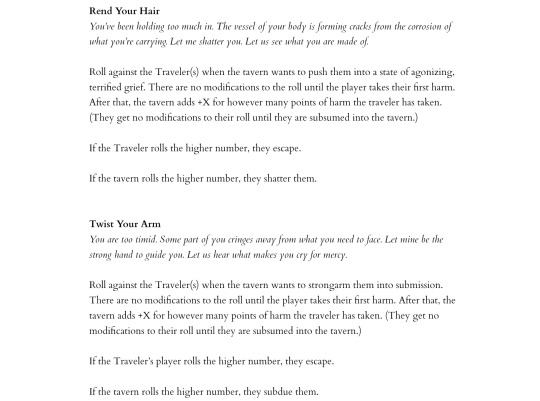
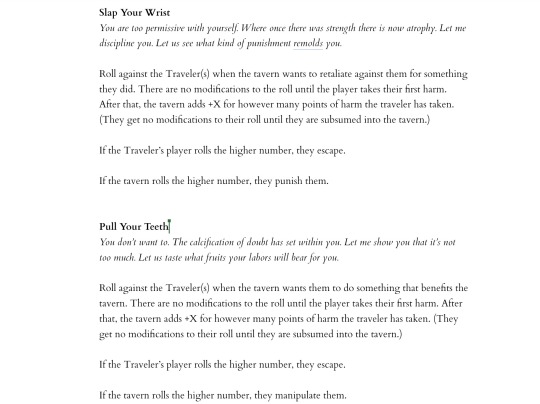
i think some of my long COVID brain fog is lifting, trying to get the basic scaffolding down for the longest rest last year felt like trying to think clearly while you fall asleep with a bad fever. now it's like, it's very very rough, but it's happening in a structured way. i have a lot more clarity of thought as i write. hopefully this trend continues and improves even more!
(also a heads up that everything from the tavern's perspective is deliberately written to evoke unhealthy interpersonal attachments, so bear that in mind before reading!)
22 notes
·
View notes
Text
VIDREV: "Short Seasons Are Killing TV" by Captain Midnight.
[originally posted august 29th 2024]
youtube
Captain Midnight is one of those creators i don't really follow because the vast majority of their work (mostly Big Corporate IP analysis) doesn't interest me, but every once in a while they'll come out with something that's EXTREMELY relevant to my interests. this one caught my eye because i've been on that "the streaming model is really bad for television" grind since 2018, and i'm always curious to see how mainstream perspectives on this stuff are evolving.
i'll just say at the start that this is a pretty good video. most everything i've watched by Captain Midnight has felt at the very least on the right track, if not always entirely on point, and the lack of cutesy overly familiar Content Creator-isms are a godsend from this type of channel. it makes for a bit of an odd duck for a full VIDREV, because i'm not here to discuss the shortcomings of what was said, but rather to take a closer look at what wasn't said.
in short, this is a video about how the now-standard 8 to 10 episode TV season in a post-streaming world has strangled much of what makes the medium unique, and he points to how many of the top-rated streaming shows are older titles with a hundred or more episodes as evidence (though he leaves out that streaming rights to shows like The Office have been the subject of contentious bidding wars in the past, a fact that would only strengthen his argument). he hits a lot of my personal favorite talking points: streaming tv is worse at good individual episodes, the idea of "filler" doesn't really make sense when applied to american television, the serial episodic structure lets you get to know characters better over time. near the end he pulls out the Netflix Marvel shows Jessica Jones and Luke Cage, each of which had a 14 episode first season that felt somehow overlong, despite their characters being literally tailor-made to support serialized week-to-week stories. these, he says, were an important early example of how the prestige streaming model encourages movie-like storytelling instead of TV-like storytelling. these are a good points, many of which i've made myself across my recent informal series of video essays about modern television writing practices.
but on the other side of all that analysis, Midnight's conclusion leaves something to be desired. here's the closing paragraph that jumped out at me, with my own added emphasis: "I love serialization on TV and I always have, I just think it can often be used better within the scaffolding of episodic stories. and for a while there it felt like TV was getting better and better at melding the two together into something truly interesting and special. but somewhere along the way that progress got lost, and many in the industry ended up thinking that serialization and short seasons were the shortcut to quality." take a good, long look at those bolded statements, and consider how important they are to Midnight's argument. after 17 minutes of wide-ranging and generally pretty good analysis of specific shows and recent trends, these three generalizations quietly paper over a gargantuan blind spot in order to get the script over the finish line.
first, "for a while there." for a while there refers to the internecine years between the dawn of the Netflix streaming era in 2011 and the eventual Wall Street-ification of all the media companies by 2018-19, when there was a big shift away from purely serialized television towards the more expensive "prestige" model we're so accustomed to now. what were the causes of this shift? what was actually going on "for a while there"? well, the 2007 writer's strike increased the writer's royalty take from home video sales, and gave them more bargaining power with networks. for this and a million other reasons, a lot of post-2007 shows saw a diminished episode-per-season count from 23 to 16-18. this was a huge boon to writers who now had more time to work on fewer episodes, meaning the quality of each individual episode shot through the roof. it helped that everyone coming into showrunning capacity at this period had years of experience working in the sitcom/cop-drama mines, developing a hunger for a show that could tell a continuous narrative within an episodic framework. with this new higher-quality television spreading away from cable-only networks into broadcast, suddenly everyone was talking about "the golden age of tv" and hyping up the medium as a place for nuanced, artful storytelling. Netflix saw where the wind was blowing and invested heavily into this trend, selling the idea that on streaming, there's no need for a set episode-per-season count for every show, no need for every episode to come in at a set length, no need to avoid more controversial adult topics for advertisers. of course, they very quickly reneged on that promise and have since become everything they promised not to be, but whatever. as Netflix succeeded, other networks decided they wanted to eat the streamer's lunch and develop their own services, making big deals with established names that made for great marketing. this meant a wave of well-publicized high-profile investment that pulled triple duty with audiences hungry for more mature media, creators hungry to make more mature media, and investors with dollar signs in their eyes. perhaps you can guess whose interests are the ones that actually matter in this equation.
but then after all that investment and quality increase, Midnight says, "somewhere along the way" the trend shifted, and "many in the industry" adopted the streaming model as the artistic ideal. now, hold on, wait. who in the industry? do you mean writers? directors? producers? executives? these roles each have wildly different relationships to the medium and to the stores of capital which allow it to be produced, and putting them all in a single consensus-bucket together as if they're all the same thing is wildly misjudged. you know what happened "somewhere along the way"? studios and streamers (and their increasingly powerful Wall Street backers) realized that favoring streaming over home video meant they didn't have to pay those costly royalties that were so painstakingly won in the 07 strike. you may recall that apocalyptically low streaming royalties were a major point of contention in the 2023 writer's strike. (the irony of Netflix starting as a DVD rental service is lost on no one.) like every service that emerges out of big tech, streaming was tailor made to break unions and steal profits without looking like that's what they were doing. they sold a big loud exciting bill of goods, got everyone to invest before regulators could catch up, made themselves an essential part of the creative economy, stole absolutely everything that wasn't bolted down while no one was looking, and left all their traditional unionized competitors scrambling to make up the shortfall. if this sounds familiar, that's because it is THE business model of the post-08-recession world. you might call it platform decay, or if you're Cory Doctorow you might call it "enshittification," but i'm gonna cut out the middle man and call it what it is: the tendency of the rate of profit to fall. it's the enclosure of the commons in microcosm, the natural process of enclosure and monopolization inherent to an open market. as is always the case with their loud proclamations of innovation, tech has invented nothing new here. it's pretty much just What Capitalism Does.
we do not need bloggers to reinvent Marxism from first principles to understand what's happening. Marx already did that for us.
another key factor for understanding what happened "along the way" comes with the development of Mini-Rooms. instead of creating a crew of staff writers experienced at multiple levels of production who work for months together to write the scripts for a single season of television, streamers like Netflix would assemble small rooms of relatively inexperienced writers paid slightly above intern rates under the guidance of maybe one experienced showrunner that were only given a few weeks to pump out scripts to please investors. this has led to shows that often feel samey, rushed, and terminally inconsistent. now, instead of writers having more time to work on fewer episodes for the same (or greater) pay, they have less time to work on fewer episodes for worse pay and virtually zero royalties. this coincides of course with cost-cutting measures across the board in streaming, with producers desperate to decrease time on set wherever possible and eating the cost of breaking union regulations because Economies Of Scale Are Fucking Absurd, meaning everyone on a production has less time to do their work, which inevitably means that their work is worse. and with TV seasons being so drastically shortened, and the gaps between seasons so drastically widened (not to mention the expectation that few if any shows will make it past season 2 (because union contracts get a pay bump at season 3)), there are fewer opportunities for young filmworkers to gain experience, build connections with fellow filmworkers, and hone their talent pool over a period of years. a show isn't just its writers, directors, and stars after all, it's an entire business operation employing hundreds if not thousands of people. for a filmworker in the 90s or before, getting a gig on a popular show could be life-changing because it was one of the rare Hollywood situations that was relatively dependable for a long stretch of time. those kinds of jobs are increasingly rare, and the alternatives are starting to look more and more like undignified freelance work than a real sustainable career.
all of these factors and so many more have had the downstream effect of making the entire industry less stable, burning out promising young talent instead of developing it, discouraging others from trying to break into the industry in the first place, and lowering the baseline quality of popular media so the viewing public sees it as less valuable. perhaps you can fill in the blanks on the ensuing race to the bottom.
this is not the result of a creative consensus. this is not something that "many in the industry" just sort of randomly changed their minds about "somewhere along the way." this is an economic trend driven by economic forces far beyond the purview of any single working person's decisions. maybe you can find interviews that suggest otherwise, maybe there were lots of writers excitedly extolling the virtues of streaming media over traditional forms-- but those people are no less vulnerable to marketing hype than you are, and why should they have been more educated about the economic realities of streaming than we were? we are, all of us, simply reacting to systems in motion, trying our best to make sense of them, searching for the silver lining that keeps us from going insane at the instability of it all. this is why it's so important to have a materialist framework for your analysis-- without that anchor you're just judging by vibes, trying to divine an explanation from consumer trends and missing the forest for the trees. look not to the words of any given writer or actor or producer, but instead to the money, to the actual flow of material power. look at the victories of organized labor, and the resultant retaliations by organized capital. Midnight's thumbnail loudly states that "WE BROKE TV," but "we" didn't do a damn thing. our consumption habits didn't do this, the creative preferences of writers or directors or showrunners didn't do this-- it was rich people with lots of money who saw an opportunity to make even more money and took it, damn the consequences.
here's my problem with consumer-side criticism. it tends to see a hard dividing line between those who make media and those who consume it, and thus generalizes all of the makers into a single heterogeneous mass that can only be understood in the vaguest possible abstract. without a materialist economic framework for understanding the flow of power in these systems, consumer-side criticism can only go so far before it crashes headlong into a big scary Marx-shaped wall. there's a door to the other side only a few feet away of course, but it's rare for a critic in this mode to walk through it because I guess they see the business side of things as irrelevant or overly complicated. like, we're here to talk about the contents of media in a very layman's death-of-the-author sort of way, to judge trends on their own merits and not rely on outside sources to skew our perspective. this is fine when the scope of your analysis is relatively small, but as soon as you start asking questions like "why isn't [thing] as good as it used to be" your consumer-end framework fails you utterly. i'm not saying Captain Midnight is a uniquely craven paragon of this particular misstep by the way, in fact on the whole i'd say he's better about this than many. this is an extremely widespread problem for a generation of critics brought up after The End Of History, when trickle-down free-market hokum was adopted as Natural Law, leaving them only the empty feelgood individualist babble of neoliberalism to interpret the world. but it's not an insurmountable problem! i've yet to meet a commie my age that didn't start in that bubble and have to work their way out of it. i certainly made my share of embarrassing neoliberal apologia before finding the immortal science! it is the process of a lifetime to unthink these blind spots, and i point them out in all kindness in the hopes that others might avoid such mistakes in future.
and frankly, everyone is asking these "why is [thing] bad now" questions because it's begun to affect every facet of our lives. it's not just movies and television shows, it's basic web services, it's the USPS, it's the healthcare system, it's jobs and housing and education, it's everything. what is it, precisely, that you want to fix? you want to see better movies and tv shows? how do you propose to make that a reality, beyond "i hope that creators/audiences adjust their habits accordingly"? to my mind, this notable tension is a perfect opportunity to point people in the direction of an actual systemic cause, and thus an actual systemic solution. do not stop your analysis at "shorter seasons are bad and i hope they stop doing that" when you could help your audience think about these things in terms of class, labor, and solidarity, by giving them an illustrative example they might apply to their own working life. there is no fix to this macroeconomic trend in reform, no union so strong it can put a lance through the heart of capital's lust for profit. maybe bringing all this up in a video would feel too political for a lot of creators in this space, but the politics are gonna do what they're gonna do regardless and it's gonna be your problem (and your audience's problem!) sooner than later. i'm not saying every video essay should be a dedicated Marxist polemic, that would get old real fast, just that the current liberal individualist framework lets the real perpetrators off the hook and limits our ability to imagine better futures. if you want to feel like your fluffy unimportant media analysis is "justified" at a time of war, genocide, and crushing economic disparity, you might start by using them to normalize a more collective, materially-grounded way of thinking about the world. it's the little things that add up most in the long run, and you'd be surprised how easy it is to make "too political" into "too important to ignore" with a little strategic frog-boiling.
that's my opinion, anyway. this is still a pretty good video essay and i think you should go watch it. i'd also recommend Midnight's review of the Borderlands movie and the interminable nostalgia of modern Marvel movies for a bit of good fun.
[final note: at the start of the video, Midnight mentions that Adam Conover also released a video about the harms of streaming television at the same time, but that it goes in a very different direction. i'm gonna give it a watch and see how it stacks up by comparison. i expect that it will have a more materialist framework (since Conover actually works in the industry) and correctly identify where the problems lay. i also expect that he'll fall flat when it comes time to talk about solutions, because like Cory Doctorow he's invested in the anti-monopoly line, which fundamentally believes that if you just break up the monopolies then capitalism will be fine actually. i guess now i'll put that theory to the test, and if i find anything interesting i may end up writing about it.]
#vidrev#video essay#video essay review#video recommendation#captain midnight#hollywood#streaming#media criticism#enshittification#tv writing#Youtube
9 notes
·
View notes
Text
zionism wants us to look away.
so it turns off the lights, the power, the signal, and commits its crimes in the dark, where we cannot see. zionism thinks that if it murders children in their beds at night, while the world is asleep, no one will notice. zionism thinks that people will not light torches and flashlights and matches until palestine is lit in red flames, flickering glow illuminating bombed hospitals and the bodies of the people that once sought refuge inside of it. zionism thinks that we will put our pillows over our heads and drown out the sound of their screams.
but what lurks in the dark only scares us more, because we know despite not seeing. so we take to the streets in frantic rage — filling our vision with red for their blood and green for their land and black and white for their freedom — and wait until it sees us. we are not blind, nor will we close our eyes.
zionism wants us to forget.
so it tells us stories of its history and its pain and its justifications, drowning out the thousands of children sobbing over the bodies of their parents, ripped apart by illegal weapons and laughing soldiers. it holds its press conferences and talks about antisemitism and nazism, unaware that it only echoes the atrocities it speaks of, committed by villains just like its people. it lies and it lies and it lies and it tells us we are liars, so that perhaps the truth will one day slip our minds.
but we are louder, eternally so, and we will be heard forever. human rights are not a piece of clothing, to be called a trend, to outgrow and then throw out to be recycled into something else, diluted and watered-down. our so-called phase will live on in the history books as the toppling of tyrants, and only then will it stop.
zionism wants us not to care.
so it makes its excuses, and suddenly an entire ethnicity are animals so undeserving of water and electricity and life. they are mongrels, zionism says, to be kicked to the curb and beaten. they are dogs, who have no need for home or a place to live. fathers are terrorists working to do everything they can to protect those they love as bombs rain down on them. mothers are extremists that yell and curse and beg for their family to be spared. children are agents of war throwing rocks at tanks. there are soldiers hiding out in those schools, and that is why they must be blown to bits.
(animals are treated better.)
but how? what did that unborn baby do to them? was it, too, planning evil savagery from the womb? we demand answers to impossible questions. we will continue to do so until zionism starts making sense, because we are only being fed too many equations that don’t add up. missiles fired at innocent families do not equate war, or anything but genocide.
(zionism says that those who stand against it are terrorists. we laugh. there must be a hell of a lot of terrorists in the world, because we flood the news with our flags.)
zionism wants us to give up.
it is hoping for the impossible. there is no defeat for a people that know that death is not the end. palestine will never die.
and halfway across the globe — resistance is in every skip of our heartbeats when we watch the news with horror. resistance is in every roar of outrage that shakes downtown during a protest. resistance is in every time we drape a flag over our shoulders to leave the house.
resistance, for me, is paint on my cheeks and dark liner i call my ‘protest makeup’. an enamel pin i wear to school, and the glare i give people who look at me funny for it. my posts. hijab. a hoodie with ‘palestine’ in arabic lettering stitched across the front.
alone, it’s nothing. but in the thrumming mass of angry protestors, waving a flag off the top of construction scaffolding, it’s everything. i promise. as long as we keep yelling, zionism hears us. it sees us. it will not forget us, and it will give up.
and then palestine will finally be free.
36 notes
·
View notes
Note
Thoughts on the Grand Festival?
it was dope! had fun hanging out, doing turf battles, and listening to the music
met a few older friends, made some new ones, met some fans, it was great especially the fans part :)
there was one… hiccup, but otherwise everything went well as far as I know
you looked so cute on stage though… :)
also, she’d never tell you this, but she was grateful you did that for her
I had fun as well; this was my first music festival so it was a lot of new things at once, but I made it through
you’ll get used to it, don’t worry
I enjoyed running around and trying all the food in between battles
yes, I knew I forgot something! there was so much, and it was all so good
ugh, yeah I definitely overate, heheh
I was fighting for my frickin life almost the whole time, but it was fun! the bowl was a super cool stage
I wanna go to more festivals like that soon :3c
climbing around on stuff I definitely wasn’t supposed to was fun too
like all that scaffolding around the main stage? epic climbing material
dude
all you said was don’t scrap the cars, you didn’t say a thing about running around in places that weren’t intended to be ran around
…
I didn’t get caught!
anyway, I liked how it was incorporated with the splatfest, which I won :)
gave something to do between matches, and I’m intrigued by how all this’ll effect stuff like fashion trends
these kinds of big splatfests always do, y’know?
excited to see what Deep Cut does after this, too
Big Guy said no more collabs for a bit, so that’s off the table for now
yeah. too bad, I kinda wanted to see what we’d sound like together, but good for them
yeah, I think it’d be cool
maybe he’d make an exception for you?
eh, probably not
#inkoming asks#four(agent 4)#ika(new agent 3)#tsunami(captain 3)#ivory(agent 8)#diamond(splatoon oc)#splatoon ask blog#grand festival
3 notes
·
View notes
Note
how do you go about planning your storyline? :) especially for your decades challenge
Hello there dearest! I’m sorry this took me a while. It’s a bit of a difficult one and I wanted to take some time to sort out the chaotic process in my brain before I tried to type it out 😅
This is just a rough outline of what works for me specifically in writing a historical story on simblr. I can’t speak to writing advice in general because it’s not something I have experience with; nor do I think this will be helpful for everyone. So please feel free to pick and choose whatever suits your fancy or ignore it all completely.
Of course, it’s time to take this below the cut, since you know it’s going to get a bit long 😉
1. Find Inspiration (Nonfiction books, Blogs, TV shows, YouTube videos, Period Pieces, etc etc…)
For a decades challenge/history based story I think this is really the starting point for me. Whether it be styles of architecture, clothing trends, a historical fact, or an individual’s story, there’s so much real life inspiration to be found for this type of story. It can often seem small, but sometimes pinpointing what you know you want to include and working it in there can be the crux of so much of a story.
I’ve said this before but one of the very first things I knew I wanted to include was the Titanic, since it was the first historical event I ever became interested in. Other examples are New Orleans as a setting, the inclusion of Storyville, and even something as small as the axe man that I included in this post.
When I find these moments of inspiration, I try to immediately transform them into tangible scenes or plot points rather than simply jot them down as a note or like a “maybe for later”. This keeps me from getting mired in too many ideas or overwhelmed with things I like, but that don’t necessarily have a place in the story.
However, sometimes it also means I will need to tweak ideas as the plot develops, such as changing the original storyline of Rosella and Lord Harrington to Rosella and Georgiana; but even with these edits, this process still creates a sort of scaffolding structure for the story as a whole. It gives me plot points or small, specific scenes that I am working and writing toward. I’m then able to allude to the eventual outcome beforehand as well as weave a larger narrative around it while still having clear points of guidance for where I want to go.
2. Connect the Dots
The “dots” here are the aforementioned scenes and/or plot points that I have written well in advance. I have dozens and dozens of these, and I’m basically constantly adding to the document where I keep my writing. This is all kept in chronological order so I can see the progression as well as where I need more narrative to fill out a decade. I generally look at this structure and ask myself: how do I realistically reach that point?
To use the example of the Titanic again: this meant somehow getting the oldest daughter of a relatively poor and close knit family aboard a ship bound for America. It meant not only putting her in contact with someone who would have access to these tickets, but also giving her a reason to leave the people she loved. Then once those larger dots are connected, I continue to focus on smaller and smaller threads, like the details of Georgiana herself or Rosella’s relationship to Zelda, until the storyline feels fully fleshed out and a character’s motivations are coming through.
3. Character Consistency
That last bit is very important to me, and I always try and think about how the characters are functioning within the framework of what I’ve written and the historical landscape. Sometimes this comes into play before connecting the dots, but often it is actually what finally puts the puzzle pieces in place. Something sim-specific here is that I really do use sims traits as guidance on who the characters are, how they interact with the world, and how the world has affected them.
So often when I am referencing a prewritten plot point or scene I will ask myself, how would that character get to this point? What may have happened that would lead them here? How does their personality interact with this historical event or point of inspiration?
Many scenes have often come from more outward facing questions, like, is this trait clear to everyone reading as well as me? Has this visibly impacted their life and done so in a sensible way? This is in part responsible for many extra scenes we saw at the end of the 1920s when a few of my best simblr babes pointed out to me that Antoine’s motivations weren’t very clear. It also helps me to fill in and round out that base storyline structure with more small, real-life scenes that showcase and develop certain traits as characters grow and interact with the world around them.
—
With all that said, this is often a very long process that involves reading or watching historical content, going over my own writing again and again, and just waiting for the day when my brain suddenly writes 5-6 scenes unprompted. Other times I’m flying by the tip of my boots, watching y’all feedback and incorporating it or reading through scenes with friends for their help.
So the process has looked very different at various points in the narrative and through the many months I’ve been writing this story. But overall, having those points to write toward as well as tangible character traits have guided the process throughout.
24 notes
·
View notes
Text
Interesting Things in the Final TotK Trailer (Part 1)
Part 2 Part 3 Part 4 Part 5
Starting at the very beginning, we get a shot of the sky above Hyrule, and see a soldier construct fighting a chuchu — that opens up some fun gameplay opportunities if you can get them to fight monsters for you or vice versa!
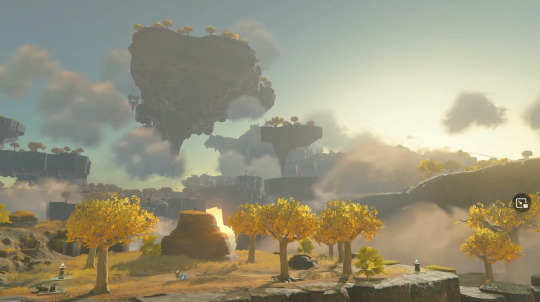
Next we see a glimpse of Hateno, which seems to have grown… mushrooms? This might be related to the underground elements. The most effected building seems to be the one that in BotW sold armour sets, so they’re probably selling something else now. My guess is either potions or fireworks! There also seems to be a new trend of mushroom hats, so maybe they’re still just doing clothes.

Next, we see a camp in Castle Town, with a little Link walking through. They’re rebuilding! Hopefully this is a quest like Tarrey Town, where we can help them out as we run around Hyrule.
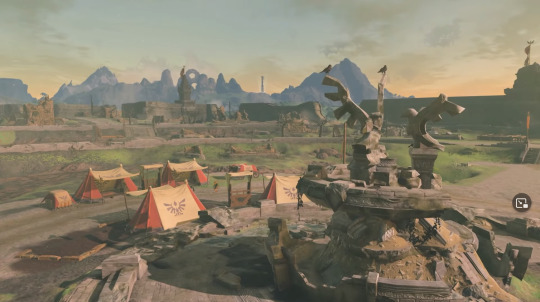
A better look at the ring structure spotted in previous trailers and the shrine-like structures! There seems to be some scaffolding around the ring, maybe the Sheikah are investigating it? The shrine-structure also has two colours (green and blue) in its spiral where before we only saw green. Is this just a better look or does it mean it’s not fully activated yet? Kakariko itself seems fine, even if some sky island debris seems to have narrowly missed it.

Typhlo Ruins, now without shadow! I wonder if we’ll find anything interesting there now we can actually see? Also, rather than disappearing altogether, the shadows surrounding it may have just gone up, as there’s a cloud seen in a previous trailer that looks oddly similar.

A mysterious structure rising from the ground… could it be a dungeon? Maybe even the Arbiter’s Grounds or Desert Colossus?

Our first glimpse of Ganondorf, all powered up by the Blood Moon. I wonder if this is when he first wakes up and rises Hyrule Castle from the ground, or just before Link fights him at the very end of the game?

Link trying to grasp Zelda’s hand, and just missing — is it just me or does his arm look a lot more malice-y than the previous times we’ve seen this scene? Maybe it bursts out just as he’s about to catch her?
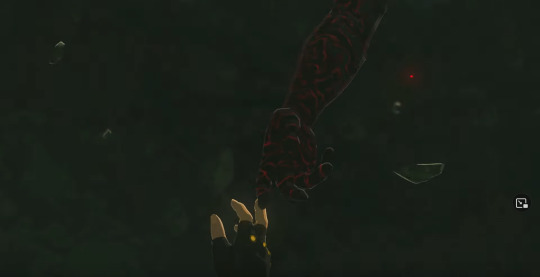
Pits opening up in the sand, possibly leading to caves below? There’s also a glyph in the background that might represent a character we see later in the trailer.
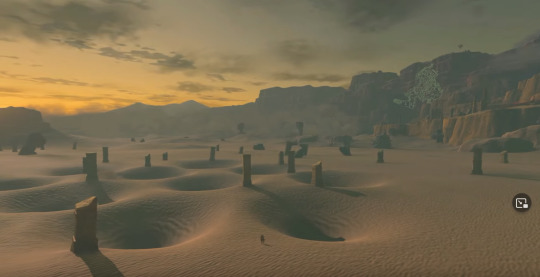
Underground! Based on the lava and rock type, this might be the heart of Death Mountain itself, and possibly a dungeon! There’s also the return of the flamebreaker armour, although it looks like its received a bit of a redesign.
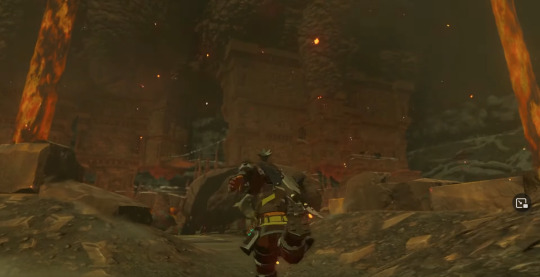
#legend of zelda#loz#the legend of zelda#totk#tears of the kingdom#totk spoilers#totk trailer#totk theory#totk theories
26 notes
·
View notes
Text
Behind the Scenes and smol cut section of A@tB under the cut!
For the nerds who would like to know more (also I worked too hard on the background and I just wanna show it somewhere so here we go)
Déjà vu was first used in 1876. What can I say, Crowley has always been a trend setter 😌
Hor-Aha is considered the second pharaoh of the First Dynasty of Egypt. Ancient Egyptian retainer sacrifice was a type of human sacrifice in which pharaohs and occasionally other high court nobility had servants killed after the pharaohs' deaths to continue to serve them in the afterlife. In Egypt, the custom only existed during the First Dynasty, from about 3100 BC to 2900 BC.
Commodus was a Roman emperor 177-192 AD. Megalomanic dictator. Created a deific personality cult, performed as a gladiator in the Colosseum.
Gladiators weren't covered in oil. But it's hot, so... Shh
The Great Schism of 1054 is the break of communion between the Catholic and Eastern Orthodox churches. Greek East (Byzantines) and Latin West (Romans) had a series of theological disputes for hundreds of years until they finally separated. I'm imagining this time period must've had a big overturn on the politics of Europa. I made the artist up, as well as the Phallus Bible (sadly).
Soho was not in fact a calm, hospitable area that agent was talking out of his ass 😂
The first attested use of the expression la petite mort in English was in 1572 with the meaning of "fainting fit". It later came to mean "nervous spasm" as well. The first attested use with the meaning of "orgasm" was in 1882. Mayhaps Aziraphale had something to do with that...
During the Reign of Terror, when noble heads rolled down the streets, folks working for them found themselves without a job. Their cooks soon invented à la carte, menu, to serve gourmet food to the lower classes. La Tour d’Argent sits at the Place de la Bastille since 1640, and played an active role in the conflicts of 1789 as a principal gathering site.
And here's what was cut from the end of chapter 1 due to repetition!
They left the massacre behind as the revolutionaries dragged Aziraphale’s executioner-to-be out to the scaffold.
(“Dressed like that, he was asking for trouble.”
Crowley looked straight at Aziraphale while saying it. They were both refreshed, not a sweat bead or streak of dirt in sight. Crowley's shades were back on and his curls looked immaculate once more. Aziraphale's new clothes were scene-appropriate, but the ghost weight of the shackles and the bites and bruises around his body still ached deliciously, underneath– Not to mention the dull, satisfying throb inside him. He wetted his lips, knowing it wasn't left unnoticed.)
Aziraphale tried his best to focus on the sunlight warming his face instead of the cacophony his other senses offered him, even if they were getting further away from the plaza. He tried to put some more, what is it called? Ah, pep in their step.
“I suppose I should say thank you? For the uh, rescue.”
Crowley looked away and stayed silent, rubbing his arm. Aziraphale pitied him.
“Well at least let me offer you a meal. I think I know just the place.”
The demon turned to look back at him. His lopsided smile had Aziraphale relieved. “What’s for lunch?”
Aziraphale returned the smile in double. “I have it on good authority that their menu is ample enough for some crêpes.”
He also had a hankering for some fish.
3 notes
·
View notes
Text
Almea is interesting because, despite being fantasy--originally of a very classic mold; it seems to have started out as much of a place for Zompist to set D&D campaigns as anything else--its author is clearly concerned with the mechanics of history: although there is no simple 1:1 comparison (Verduria is not an allegory for France; Ctesifon was not Rome; Xurno is not Russia), the way the world is presented, and the way in which the author explores it, meshes well with the major trends of our own world and how we understand them. Almea is a world you can make historical atlases of; it is a world with its own history of colonialism and international relations and a similar technological arc. It is, in short, a set of fantasy starting conditions (”what if three million years ago aquatic elves and swamp orcs fought an apocalyptic war, and in the aftermath a new hominid civilization tried to re-run Earth history”) whose consequence are worked out in a fairly Earthlike way.
You might contrast this with Middle-Earth--for all that Tolkien had a pretty good head for history and language, he’s much more interested in exploring his fictional history through the framework of legendary narrative. Zompist has the Historical Atlas and the Almeopedia; but Tolkien’s big work is the Silmarillion, a work of history which is primarily concerned with telling that history in the epic mode. You can’t really make a historical atlas of Middle-Earth--for one, it’s not detailed enough. Corners of the world which fall out of the story, like the outer provinces of Arnor after the collapse of the northern kingdom, basically just disappear. There might be something in the big gaps in eastern Rhovanion and Rhun, but it’s clearly not relevant to the stories Tolkien wants to tell, so we have scant sense of what that is.
Comparing different approaches to worldbuilding is interesting to me, because once you start doing that, you really expose how shallow the imagination is of people who think of worldbuilding as, like, a secondary accessory to “real” storytelling. It is a fairly common position that worldbuilding is, I don’t know, basically a second-order activity, an indulgence at best, and that the real purpose of worldbuilding is to provide a good foundation for “proper” stories, which the ends of worldbuilding ought to serve. To me, though, worldbuilding has always been an interesting activity in its own right. Often a much more interesting activity, because how you design a world, the internal and external logic you approach it with, and how you present the results of that design, will not only, as a matter of inevitable consequence, cause certain stories to emerge from that world, in a way that feels as natural as breathing, but will give a strong scaffold, a supporting superstructure that helps those stories fit together in a way that transcends their individual arcs and themes.
For example, all stories that you might tell about Almea are part of an analytic history of a fantasy world that is About what it means to approach a fantasy setting with the tools of modern historiography, political analysis, and sociology, as much as they are About the individual themes of those stories. All stories you might tell about Middle-Earth are About reclaiming the epic mode for modern fantasy, and the possibility of redemption in a world marred by suffering, as they are the Silmarils or the One Ring. Bad worldbuilding often is merely an adjunct to storytelling--and that’s how you get shared settings that feel like a hodgepodge whose elements have no coherent relationship to one another, because the story someone wants to tell comes first, and, well, they’re going to force it to work in the setting whether it’s natural to it or not. And even good writers can build (or contribute to) lousy, boring worlds using this approach.
42 notes
·
View notes
Text
writing a sw austen themed thing is really interesting because like, one of the things about austen’s women is they lead extremely narrow lives within the confines of a very specific kind of upper-class femininity. you can write things like pride and prejudice and zombies, and I heartily enjoy that, or you can go odd postmodern routes that seek to simultaneously modernise and girl-power the text whilst simultaneously excising many of the questions of agency, gender, and female interrelationship that exist in the original- i wish to uphold no classic works as the epitome of feminism for many reasons, but this trend bothers me greatly - but one of the interesting things about austen to me is the utter worlds of fascinating plot and comedy she details within those confines, and if I’m writing that kind of AU i don’t want to break that. and it brings this thing up that in some ways it feels odd to have blaster and lightsaber wielding action heroines engaged in croquet and cross stitch and interested in their marriages and homes and children, but comparing austen to sw i find actually underlines the poverty of female characterisation within star wars. austen’s women hold their own distinctiveness abroad broader patchworks of human comedy and are sharp and flawed and interesting; a catherine morland, an elizabeth bennet, and an anne elliot are three very different things. as much as these women’s lives are scaffolded around traditional goals of marriage and family, their lives are lived out in relation to other women and in configurations far more complex than “frenemy.” austen can have an endless number of stitchery-in-the-parlour scenes because every woman is distinct enough that comedy and drama arise simply from their proximity in the same place, and this is just.... not something star wars can easily say for itself. it’s the epitome of strong enough to carry the man versus strong enough to carry the narrative
#like it's actually a fun writing excersise for me#the main thing i'm ammending the Draft for is... it needs more women#i think the famous declarations and ballroom scenes get the most focus#but everytime i reopen an austen it's the women who grab me again
27 notes
·
View notes
Text
SSR Vil Schoenheit Dorm Uniform Personal Story: Part 2
"Even the margins of a monochromatic page."
(Part 1) Part 2 (Part 3)

[Pomefiore Dorm – Ballroom]
Vil: You there! Straighten your back! You must always watch your posture while walking!
Pomefiore Student A: Y-Yes, sir!
Vil: You over there, your hem is frayed.
Vil: Make sure to pay full attention to the finest details of your attire as well. Outfit maintenance is also a part of fashion.
Pomefiore Student B: Thank you very much for the advice!
Vil: And… then there's your hair. Is that supposed to be fashionable?
Vil: You've so preoccupied yourself with the current trends, that you have neglected to determine if it even looks good on you.
Vil: First, know thyself. Only then can you ride the wave of fashion.
Pomefiore Student C: M-My apologies!

[Pomefiore Dorm]
Epel: Man, Vil-san is in perfect form today, too… I can hear his voice all the way here.
Epel: When this first started, I thought it'd be far better to be stuck cleaning than having to deal with him saying all sorts of stuff with my appearance…
[wind blows]
Epel: BUT I DEFINITELY GOT THE WORSE END OF IT!
Epel: I can't believe I gotta clean the outsides of all the windows of the huge castle-like Pomefiore dormitory!
Epel: And without a scaffold, all the way to the highest windows!
Epel: Just how many meters is it down to the ground…?
Epel: What'll happen if I slip…?
Vil: Epel!
Epel: Ack!? A voice from inside the building…? Vil-san!?

Vil: Will you be able to finish wiping down all the windows before the day is out?

Epel: Y-Yes, I will!
Epel: So please don't talk to me right now! If I let go of the windowsill, that'll be the end of my story!

Vil: Fufufu, what focus. Keep up the good work.

[Pomefiore Dorm – Hallway]
Pomefiore Student A: Siigh… Vil-ryōchō's curriculum is way harder than I thought it'd be…
Pomefiore Student B: What he's saying might be right and all, but it'd be great if he could be a little nicer…
Pomefiore Student A: I keep feeling like the Dorm Leader is always watching us, so there's no space to even take a breather.
Epel: I'm completely wiped out from wiping down every single window.
Epel: Maybe he was only targeting us to deal with all this exhaustive stuff...
Pomefiore Student A: No way! I don't believe that our Dorm Leader would do such a thing like that!
Pomefiore Student B: ...However, the Dorm Leader is just shooting out commands, while himself doing nothing but observing from his lofty throne.
Pomefiore Student A: Well, that's because he's on a completely different level from the rest of us. So essentially… He doesn't have to do anything.
Pomefiore Student B: Even so, it doesn't sit well with me. Why do we have to be the only ones who're dealing with all these hardships…?
Pomefiore Student A: Let's drop it. If this continues, we'll just be speaking ill behind his back. That sort of thing isn't beautiful, right?
Pomefiore Student B: …You're right. My body is completely exhausted, so I should sleep now to prepare for tomorrow.
Epel: That's for the best, probably. I think we're the only students still awake… Huh?
Epel: Looks like the lounge lights are still on.
Pomefiore Student A: I can hear a conversation… Is someone there?
Pomefiore Student B: I'm kind of curious now…

[Pomefiore Dorm – Lounge]
Rook: …Vil. You had an early morning meeting for the commercial shoot again today, didn't you?
Rook: I think you should let your fair skin rest sometime soon.
Vil: I'd like to, but my duties are still not through, so I'm afraid it's not possible.
Vil: I must organize all of these memos.
Rook: What's written on them?
Vil: A list of the dorm students' height and weight, as well as notes on their posture and walking style. Also, the list of herbs that would suit their constitutions.
Rook: You are simply merveilleux for keeping an eye on each student's status like this.
Rook: Even though I don't think any of them have noticed the extent of your efforts...
Vil: I have no need for them to notice. After all, I'm not doing this because I wish to be liked by them.
Vil: Students chosen for Pomefiore should be strong and beautiful.
Vil: As the Dorm Leader of Pomefiore, I have a duty to mentor those more inexperienced students.
Vil: …Oh my, is it that late already?
Rook: Are you finally ready to sleep?
Vil: Not at all. It's time for me to work out.
Rook: My goodness, you truly do fill me with awe.

Epel: …Did you hear that?
Pomefiore Student A: Yeah…
Pomefiore Student A: Thinking that Vil-ryōchō didn't have to do anything because he's already beautiful enough… There should be a limit to our foolishness.
Pomefiore Student B: Right. And moreover, for us to complain about someone who works even harder than we have…
Pomefiore Student B: How could we have been thinking something so stupid!?
Pomefiore Student A: No matter how strict the curriculum is, let's trust in Vil-ryōchō and do our very best.
Pomefiore Student B: You're right!
Epel: Yeah. I'm going to do what Vil-san told me and continue to clean the windows, too.
(Part 1) Part 2 (Part 3)
#twisted wonderland#twst#vil schoenheit#epel felmier#rook hunt#twst vil#twst epel#twst rook#twst translation
40 notes
·
View notes
Text
I'm having some serious feelings *tm about the "dating to breakup or dating to get married" trend
because on one hand seeing people being to open and honest and firm in their expectations of a relationship is a good thing. communicating your expectations to a partner or potential partner is a good thing. And I'm glad that a larger part of the population is finally learning those communications.
But I am having such a disproportionate emotional response to this trend. like I don't know if it's religious trauma or just the reaction of a bitter tired queer raging against some hetero-normative bullshit but I fucking hate this trend.
like I'm trying to be logical because ultimately my emotional responses are my own responsibility to deal with. But I really fucking hate this trend. it makes me unreasonably angry. I want to scream at yet another arbitrary scaffolding being put around the human experience.
Why can't we just be with someone to be with them? why does every single fucking relationship we have need to fit into neat little categories with labels and stages and goal marks and expectations?
Why does every relationship have to serve such a strict fucking purpose?
isn't that exhausting? Aren't you so fucking tired of having to corral all of your human experiences inside set little paths?
like I am almost definitely having an existential crisis over the society at large right now. But please, if you're hopping on this trend right now seriously consider if you're adhering to these extremely strict expectations because you genuinely want that life or if your just tired and you think it will make your relationships easier to navigate.
If you're not 100% invested in a dating-to-marry lifestyle then do not advertise that you are. Take some time to really consider you're expectations and communicate that instead.
4 notes
·
View notes